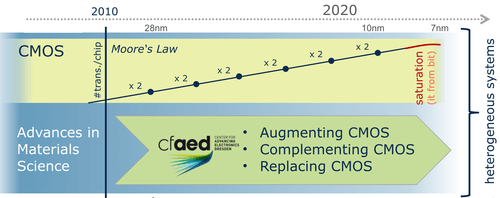"Today, organic materials are slow in their activity, but their cost is extremely low. We plan to make them faster using ordered structures, similar to how we currently produce monocrystalline silicon, but - we are not there yet", explains researcher and scientist Stefan Mansfield.

"Organic semiconductors will become the "crude oil" of the information age while Moore's law reaches its end at the level of 7-nanometer junctions," says Stefan Mansfield, chair of the Department of Organic Devices at the Technical University of Dresden. "We are building an infrastructure that will expand the main technology today for the production of integrated circuits (CMOS=Complementary Metal Oxide Semiconductor) together with organic materials using silicon nanowires, organic integrated circuits with innovative configurations and carbon nanotubes."
It will be possible to reach this goal with the use of transparent electronic components for information processing, with the use of DNA scaffolds and templates for the development of particularly advanced electronic components and with the use of processors that process chemical signals. In order to manage all this diversity within the framework of broad systems, specially adapted designs, energy efficient and protected against failures will be needed - and this is exactly what is being done today at the university for the future with the help of an interdisciplinary team of physicists, chemists, biologists, computer scientists and electronics engineers. "Today, organic materials are slow in their activity, but their cost is extremely low. We plan to make them faster using ordered structures, similar to how we currently produce monocrystalline silicon, but - we are not there yet", explains researcher and scientist Stefan Mansfield.
Professor Jeronimo Castrillon also participated in the development efforts by adapting methods of information processing processes to organic materials in order to overcome the limitations of CMOS methods. "I try to adapt all the usual software practices to organic materials," explains the researcher. "We develop systems of 'highly adaptive efficient computing' [HAEC] using parallel programming models and real-time operating systems". In addition, the researchers utilize ideas from the field of computational biology, such as anchoring organic circuits on glass surfaces, in order to carry out information processing processes that will be more efficient than those currently carried out by semiconductor materials. "The goal is to reduce energy requirements as much as possible while building all the tools we use today, for example, the array of a lab-on-a-chip," explains the researcher.

2 תגובות
I read in one of the articles on the website that the gap between 2 transistors can be reduced to a minimum distance of about 4 nanometers until quantum phenomena begin to affect the input signal (current) and the output signal (current) of the transistor.
That is, Moore's Law will be valid until the researchers and engineers manage to reach the 4 nanometer gap. In a year and a half, two years, the "7 nanometer" processor will be released, followed by the "4 nanometer". very soon.
Announced ….. that they are not there yet??
The article describes exaggerated announcements instead of describing primary and basic research with hopes but a long way from practical use.